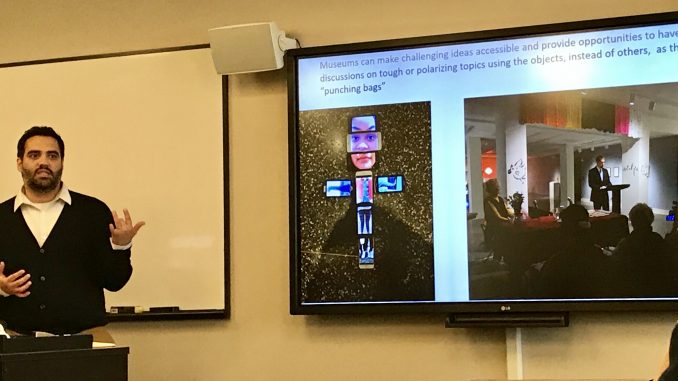
On Oct. 4, 2019, New Paltz leaders and professors gathered together in the Faculty Development Center at College Hall to discuss the Samuel Dorsky Museum’s role in building an interactive college curriculum.
The Dorsky Museum is a monument to SUNY New Paltz’s dedication to the arts, and it functions not only as a home for static paintings, but a place to visit in order to enrich one’s academic experience and expand one’s mind.
Throughout the workshop, hosted by Zachary Bowman and Frank Boyer, it became clear that the Dorsky is not only a cultural asset to our campus and the greater community, but an excellent place for expanding and enhancing learning across disciplines. By thinking critically about artwork, students can discuss their perceptions of certain objects, and how their biases may affect their worldviews. When we look at and discuss art, we can build empathy by learning about what other people see.
“We offer applied cognitive and experiential learning opportunities, as well as social learning opportunities that can get students excited about applying what they’re learning in the classroom,” said Bowman, manager of education and visitor experience at the Dorsky.
During his presentation, Bowman shared a touching story about being a young boy at the Dallas Museum of Art. He entered the museum feeling uncomfortable and out of place, but a security guard noticed his apprehension and made him feel comfortable by orienting Bowman to the environment. By breaking down that barrier of fear, the guard introduced Bowman to a new world that would become not only a place of safety for him, but his life’s work. With this anecdote, he demonstrated how making museums a welcoming and accessible place for students could encourage lifelong museum attendance and learning.
“It’s really important that you know this museum exists on this campus for you. It is your resource,” Bowman said.
Within his presentation, Bowman also discussed why field trips are particularly enriching for students. Museum “field trips,” or class excursions for college students, provide memorable social interactions that allow pupils to loosen up and open their minds. By maintaining a sense of play during field trips, kids and young adults engage in social learning as well as academic learning.
One way that students may get involved with the Dorsky is through ekphrasis writing. Ekphrasis is the act of writing about a piece of art and expanding upon its meaning through poetry. To write an ekphrasis piece, visit the Dorsky, and stare at a piece of art until it starts to take on a greater meaning. Write about it. During the Oct. 4 workshop, Bowman demonstrated how to use ekphrasis with museum artifacts. Using an ancient Sumerian statue as inspiration, faculty wrote their own ekphrasis poems and share them.
Within organized classes or on their own time, students can use this practice to strengthen their poetry writing. If ekphrasis suits you, consider submitting your work to the museum. All graduate and undergraduate students are invited to submit written responses about works in the Dorsky’s permanent collection before Nov. 5. Works selected will appear in a digital publication on the museum’s website.

